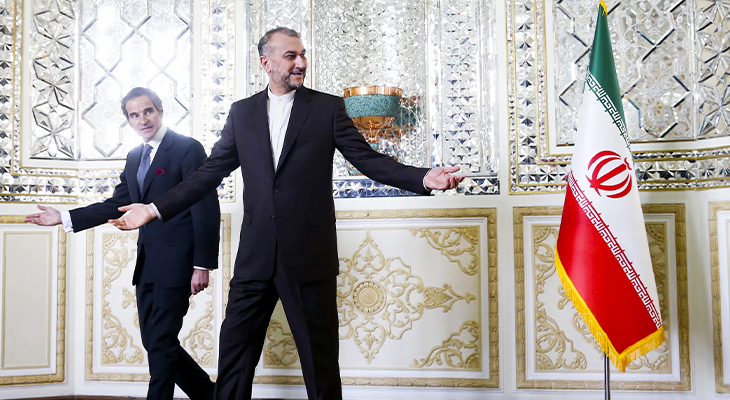EU’s high representative for Foreign Affairs and Security Policy, Josep Borrell, said on August 15 that both the EU and US were studying Iran’s written response and hoping to restore the tattered nuclear deal. There was no timeline given on when the world powers would respond, but Iran’s official media said Tehran expected a reply in two days.
Iran’s Hard Line
Despite slow progress made in Vienna’s indirect US-Iran negotiations, which resumed on August 4, Iran seems to be showing inflexibility on key points of disagreement, which could be outlined as follows:
1. Conditional agreement:
Although EU’s roadmap had been described as ‘final’ and non-negotiable, Iran has stalled to offer a response, suggesting Tehran still wouldn’t take up the EU-mediated proposal, despite warnings there would be no more negotiations.
Media sources have quoted three issues that are holding up the deal: uranium traces, US ultimate guarantee, and IRGC removal from terror list.
Tehran aims to include mechanisms that would allow Iran to accelerate its nuclear activity should negotiations fail. Tehran also wants the US to guarantee no future administration would break out on a revived pact the way President Donald Trump did, and to also leave foreign companies and investments intact in case Washington decides to withdraw in future.
Iran’s minister for foreign affairs Hossein Amir-Abdollahian on August 15 said without clarifying any specifics that the US had given a verbal agreement and showed flexibility on Tehran’s first two conditions, but that he demanded flexibility on the third issue, and a written response from the American counterpart.
Sources said Washington had intended to lift sanctions on a few Iranian companies with links to the Islamic Revolutionary Guard Corps (IRGC). Washington also is signalling willingness to mediate between Iran and the International Atomic Energy Agency (IAEA) to bring to closure probes of Iran’s covert nuclear material operations. Yet, Iran’s demands for compensation in case US abandons the deal do not seem to be well received by Washington, which may drag the negotiations longer.
2. Mixed signals:
Soon after Iran’s submission, it sent mixed messages to its American counterpart: following a period of busy meetings among the negotiation taskforce, Iran issued several statements expressing persistent disagreements with EU negotiators. On the same day, Iran’s Secretary of Iran's Supreme National Security Council (SNSC) Ali Shamkhani said in a meeting with Irani members of the parliament that his country would ‘never back down from red lines’, adding that EU’s proposal did not give clear answers.
Yet by contrast Iran has shown flexibility on other issues. A day after US Foreign Secretary Antony Blinken marked in a tweet Iranian-American businessman Siamak Namazi’s 2,500 days anniversary in ‘wrongful’ detention, Iran expressed willingness to address this file seeking to avoid being blamed for the failure of the negotiations.
3. Targeting of US military base:
Drones belonging to Iran-backed militias bombed US base in At Tanf on the Iraqi-Syrian border, in what seems to be a retaliation to an Israeli attack on an arms convoy headed to Hezbollah in Lebanon. These developments indicate Iran’s wish to demonstrate to Washington that if Israel attacks any of Iran’s nuclear facilities, it would not hold back on retaliating, and that US military targets would not be out of bounds.
4. Displaying indifference:
Manouchehr Mottaki, Minister for Foreign Affairs of Iran, said on August 16 that sanctions “did not mean death”. A strong statement, which might suggest Iran’s intention to show indifference to whether a deal could be reach, perhaps even a readiness for talks to fail.
Such attitude also suggests Iran’s persistence on its ‘red lines’, for experience have taught Tehran that a deal with the US could never to be taken for granted. US mid-term elections are around the corner, and 12 months later the 2024 elections could see a new Republican president come to office. And to this effect Iran has been building strategic partnerships with countries like Russia, China, and Venezuela to alleviate some of the effects of Western sanctions.
US Hesitation
The US approach to Iran’s demands is manifold and can be outlined in the following:
1. To consider Iran’s response:
US Foreign Secretary Blinken welcomed Iran’s response, suggesting this could form a basis for reaching an agreement. The draft included several concessions the US is willing to make for the Iranian side, especially on issues related to IRGC’s uranium issue if Iran is willing to cooperate with IAEA.
And while US seems to have been unwilling to make any compromise on key issues, the flexibility it has displayed towards the latest response may indicate the current administration’s preference for diplomacy over other intrusive, and perhaps costlier, options.
2. To beckon more sanctions:
US foreign ministry had warned Iran might face new sanctions if the latter does not accept the current draft. But as Iran inches capability for nuclear weapons, Washington might be taking a carrot-and-stick approach to the nuclear negotiations.
3. To opt for military intervention:
Washington has an understanding with Tel Aviv that a military decision ultimately might be necessary to prevent Iran from securing nuclear weapons. Israeli and US ministers for defence on August 17 discussed on a call what options might be viable to preventing Iran from coming closer to nuclear arms. This means a strike on Iranian facilities is possibility and is an indirect warning to Tehran if it remains inflexible.
In summary, Iran’s latest submissions certainly signals Iran’s stalling the negotiations, having realised the EU believes it has reached a dead-end. Tehran understands that what follows on the failure of the nuclear negotiations would be costly for the US, coming at a timing when Washington is pre-occupied with the ongoing Russo-Ukrainian war and China’s escalation over Taiwan. Washington is out of its depth, it may seem to Tehran, for the only viable alternative other than a military strike is to continue with the negotiations, perhaps indefinitely, which would not restrict Iran’s ability to acquire nuclear weapons.


